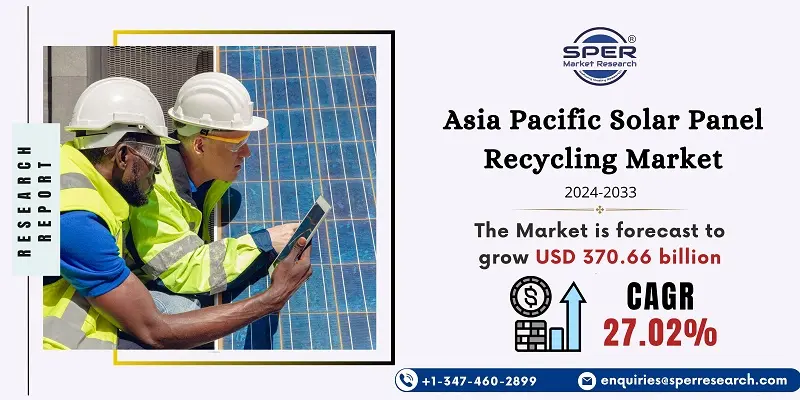
Asia Pacific Solar Panel Recycling Market Growth, Size, Trends, Demand, Share and Future Outlook
Asia Pacific Solar Panel Recycling Market Size- By Material, By Panel Type, Regional outlook, Competitive Strategies and Segment Forecast to 2033
| Published: Jul-2024 | Report ID: POAE2468 | Pages: 1 - 158 | Formats*: |
| Category : Power & Energy | |||
- December 2021; With the rising establishment of solar panels chargers in China, India, Japan, and other Asian nations, the interest for reusing of this sunlight powered charger squander is additionally expanding. The rising examination and advancements in sunlight powered charger reusing are likewise supporting the utilization of the equivalent. Researchers at the Indian Institute of Technology have figured out how to make sunlight powered charger's recyclable that is by settling cross breed perovskite-based sun oriented to deliver power.


| Report Metric | Details |
| Market size available for years | 2020-2033 |
| Base year considered | 2023 |
| Forecast period | 2024-2033 |
| Segments covered | By Material, By Panel Type |
| Regions covered | China, Japan, Korea, India, Australia, Philippines, Singapore, Malaysia, Thailand, Indonesia |
| Companies Covered | Canadian Solar Inc., EIKI SHOJI Co. Ltd., Etavolt Pts. Ltd., First Solar Inc., Mitsubishi Electric Inc., Reclaim PV Recycling Pty Ltd., SunPower Corporation, Trina Solar Co. Ltd., Yingli Energy Co. Ltd. |
- Solar Panel Manufacturers
- Recycling Companies
- Waste Management Firms
- Government and Regulatory Bodies
- Environmental Organizations
- Solar Farm Operators
- Utility Companies
| By Material: |
|
| By Panel Type: |
|
- Asia Pacific Solar Panel Recycling Market Size (FY’2024-FY’2033)
- Overview of Asia Pacific Solar Panel Recycling Market
- Segmentation of Asia Pacific Solar Panel Recycling Market by Material (Glass, Metal, Others)
- Segmentation of Asia Pacific Solar Panel Recycling Market by Panel Type (Silicon-based, Thin Film-based)
- Statistical Snap of Asia Pacific Solar Panel Recycling Market
- Expansion Analysis of Asia Pacific Solar Panel Recycling Market
- Problems and Obstacles in Asia Pacific Solar Panel Recycling Market
- Competitive Landscape in the Asia Pacific Solar Panel Recycling Market
- Impact of COVID-19 and Demonetization on Asia Pacific Solar Panel Recycling Market
- Details on Current Investment in Asia Pacific Solar Panel Recycling Market
- Competitive Analysis of Asia Pacific Solar Panel Recycling Market
- Prominent Players in the Asia Pacific Solar Panel Recycling Market
- SWOT Analysis of Asia Pacific Solar Panel Recycling Market
- Asia Pacific Solar Panel Recycling Market Future Outlook and Projections (FY’2024-FY’2033)
- Recommendations from Analyst
1.1. Scope of the report1.2. Market segment analysis
2.1. Research data source
2.1.1. Secondary Data2.1.2. Primary Data2.1.3. SPER’s internal database2.1.4. Premium insight from KOL’s
2.2. Market size estimation
2.2.1. Top-down and Bottom-up approach
2.3. Data triangulation
4.1. Driver, Restraint, Opportunity and Challenges analysis
4.1.1. Drivers4.1.2. Restraints4.1.3. Opportunities4.1.4. Challenges
4.2. COVID-19 Impacts of the Asia Pacific Solar Panel Recycling Market
5.1. SWOT Analysis
5.1.1. Strengths5.1.2. Weaknesses5.1.3. Opportunities5.1.4. Threats
5.2. PESTEL Analysis
5.2.1. Political Landscape5.2.2. Economic Landscape5.2.3. Social Landscape5.2.4. Technological Landscape5.2.5. Environmental Landscape5.2.6. Legal Landscape
5.3. PORTER’s Five Forces
5.3.1. Bargaining power of suppliers5.3.2. Bargaining power of buyers5.3.3. Threat of Substitute5.3.4. Threat of new entrant5.3.5. Competitive rivalry
5.4. Heat Map Analysis
6.1. Asia Pacific Solar Panel Recycling Market Manufacturing Base Distribution, Sales Area, Product Type6.2. Mergers & Acquisitions, Partnerships, Product Launch, and Collaboration in Asia Pacific Solar Panel Recycling Market
7.1. Asia Pacific Solar Panel Recycling Market Size, Share and Forecast, By Material, 2020-20267.2. Asia Pacific Solar Panel Recycling Market Size, Share and Forecast, By Material, 2027-20337.3. Glass7.4. Metal7.5. Others
8.1. Asia Pacific Solar Panel Recycling Market Size, Share and Forecast, By Panel Type, 2020-20268.2. Asia Pacific Solar Panel Recycling Market Size, Share and Forecast, By Panel Type, 2027-20338.3. Silicon-based8.4. Thin Film-based
9.1. Asia Pacific Solar Panel Recycling Market Size and Market Share
10.1. Asia Pacific Solar Panel Recycling Market Size and Market Share By Region (2020-2026)10.2. Asia Pacific Solar Panel Recycling Market Size and Market Share By Region (2027-2033)10.3. China10.4. Japan10.5. Korea10.6. India10.7. Australia10.8. Philippines10.9. Singapore10.10. Malaysia10.11. Thailand10.12. Indonesia10.13. Rest of APAC
11.1. Canadian Solar Inc.
11.1.1. Company details11.1.2. Financial outlook11.1.3. Product summary11.1.4. Recent developments
11.2. EIKI SHOJI Co. Ltd.
11.2.1. Company details11.2.2. Financial outlook11.2.3. Product summary11.2.4. Recent developments
11.3. Etavolt Pts. Ltd.
11.3.1. Company details11.3.2. Financial outlook11.3.3. Product summary11.3.4. Recent developments
11.4. First Solar Inc
11.4.1. Company details11.4.2. Financial outlook11.4.3. Product summary11.4.4. Recent developments
11.5. Mitsubishi Electric Inc.
11.5.1. Company details11.5.2. Financial outlook11.5.3. Product summary11.5.4. Recent developments
11.6. Reclaim PV Recycling Pty Ltd.
11.6.1. Company details11.6.2. Financial outlook11.6.3. Product summary11.6.4. Recent developments
11.7. SunPower Corporation
11.7.1. Company details11.7.2. Financial outlook11.7.3. Product summary11.7.4. Recent developments
11.8. Trina Solar Co., Ltd.
11.8.1. Company details11.8.2. Financial outlook11.8.3. Product summary11.8.4. Recent developments
11.9. Yingli Energy Co. Ltd.
11.9.1. Company details11.9.2. Financial outlook11.9.3. Product summary11.9.4. Recent developments
11.10. Others
SPER Market Research’s methodology uses great emphasis on primary research to ensure that the market intelligence insights are up to date, reliable and accurate. Primary interviews are done with players involved in each phase of a supply chain to analyze the market forecasting. The secondary research method is used to help you fully understand how the future markets and the spending patterns look likes.
The report is based on in-depth qualitative and quantitative analysis of the Product Market. The quantitative analysis involves the application of various projection and sampling techniques. The qualitative analysis involves primary interviews, surveys, and vendor briefings. The data gathered as a result of these processes are validated through experts opinion. Our research methodology entails an ideal mixture of primary and secondary initiatives.



Frequently Asked Questions About This Report
PLACE AN ORDER
Year End Discount
Sample Report
Pre-Purchase Inquiry
NEED CUSTOMIZATION?
Request CustomizationCALL OR EMAIL US
100% Secure Payment






Related Reports
Our Global Clients
Our data-driven insights have influenced the strategy of 200+ reputed companies across the globe.






















